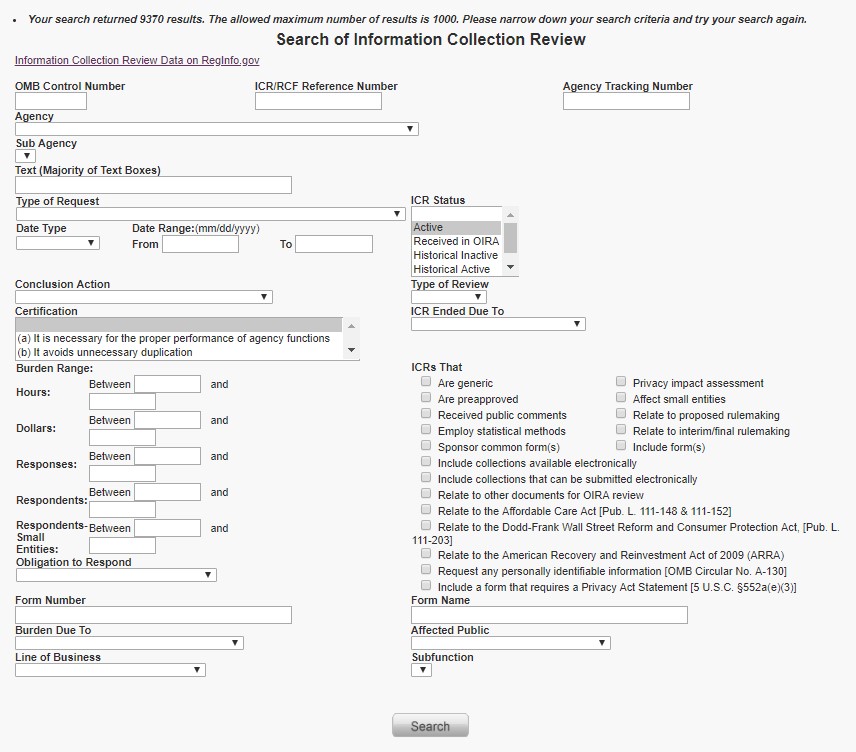Insight
December 7, 2018
A $42 Billion Error
As part of its responsibility under the Paperwork Reduction Act (PRA), the Office of Information and Regulatory Affairs (OIRA) maintains a running database of all the “information collection requirements” (ICRs) – forms, basically – that the public has to file in order for agencies to carry out their regulatory missions. Part of the data OIRA maintains are the cumulative estimates of annual paperwork burden hours and costs. This database covers thousands of such ICRs and their individual estimates, and given that volume it is not surprising that errors do creep into the data.
This past week brought a particularly significant error to light. An adjustment to a health care cost reporting requirement dialed back its cost estimate from nearly $42 billion to $0, saying that the previous projection was “submitted in error.” Such an instance highlights need for greater transparency and scrutiny in agencies’ development of these paperwork requirements.
This instance is problematic both on its face and as one digs into some of the supporting documentation. At $41,875,085,608, the original estimate exceeded the gross domestic product of Serbia. Now it is at zero. Here is the full rationale for the change: “Cost Estimates aren’t normally reported for OMB submission. Cost estimates were submitted in error on previous approval.” How often do ICRs actually include a cost estimate? For perspective, as of last week, there were 9,370 active ICRs. Out of those, 7,117 reported a cost estimate of zero (roughly 76 percent).
These totals can fluctuate from day to day, but the variance is often minimal. Thus, only roughly a quarter of the federal government’s paperwork estimates include an easily accessible estimate of the costs they impose on affected entities. Therefore, while it may not be “normal,” estimating costs still happens and there is a section in each ICR entry dedicated to such an endeavor. Indeed, this raises the very important question of why such a practice is not the norm.
A deeper examination of the supporting documentation behind such an estimate yields even more questions than answers. First, on the input side, there does not appear to be any insight gleaned from the public on the matter as no comments were filed on the entry during its approval stage. Second, the official reason given for the change in this ICR entry neglects to address the cost question at all, merely stating: “The change in burden is due to a change in the number of respondents from 14,185 in May 2014 to 14,398 in October 2014.” Considering the version of the ICR immediately prior to it had a cost estimate of zero, there seems to be nearly 42 billion reasons for greater clarity. Finally, looking to the “supporting statement” that lays out the agency’s calculations, one finds an estimate of only $113.6 million in costs – roughly 0.3 percent of the more public-facing estimate. The commensurate statement for this more recent edition sees only a $30 million increase in that figure. Simply put, there appears to have been no rhyme or reason for including $41.9 billion in projected costs. Assuming this was simply an error in perhaps data entry, it is still a sizable one.
Unfortunately, as egregious as this error was and as opaque as the process seems, this is hardly the first time it has been an issue. In 2013, AAF found an erroneous hour estimate that amounted to 5.2 million years of paperwork. We have also previously examined the discrepancy – often quite large – between the “official” estimate and that provided in the supporting documentation. The Government Accountability Office (GAO) has also recently found numerous examples of dissonance between these estimates. GAO includes 11 recommendations to various agencies to institute better vetting processes in this area.
There is a touch of irony that this error in cost reporting comes from an ICR that asks skilled nursing facilities (SNFs) “to report the health care costs [emphasis added] to determine the amount of reimbursable costs for services rendered to Medicare beneficiaries.” If one of these SNFs had included an inexplicably incorrect cost figure on the scale of billions of dollars in their report, that would likely raise several red flags. Granted, the ICR clearance and burden estimate process is ultimately a more academic exercise than that. Nevertheless, if we are to charge government agencies with producing such estimates in the interest of transparency and sound data, there ought to be greater scrutiny upon how they arrive at such estimates and increased focus on the public’s ability to access accurate projections easily. Errors such as the one apparently corrected this past week stand as important examples of this.












